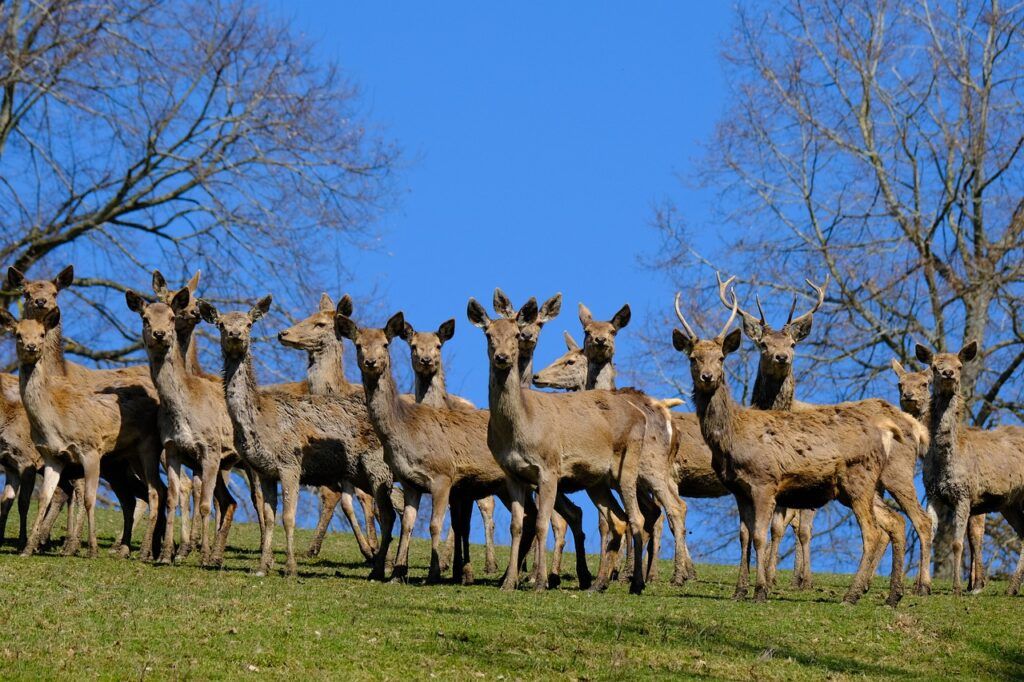If you’ve ever spent any time in wooded areas, you’ve surely heard random rustling in the leaves.
While it may sound like a large animal such as a deer, it’s most often squirrels or chipmunks making all that racket.
This seems completely counterintuitive doesn’t it?
If something so small can be so loud, how is it that something so large can be so silent?
That leads us to the topic of the day: How are deer so quiet?
Deer are able to move around the forest quietly because of their small, soft hooves and their slow, cautious movements. Their sensitive hearing and natural camouflage give them extra time to move when they sense a predator nearby. Deer are also social animals which allows them to communicate with each other when there is a nearby threat.
Small, Soft Hooves
Deer hooves are quite small relative to their body.
This gives them a strategic advantage in the stealth department as there is less surface area in contact with the ground. Translation: Less opportunity to snap a twig and make sound!
But the size of their hooves isn’t the only benefit, it’s what lies beneath that really helps; a soft, rubbery sole.
This sole assists deer when traversing rough terrain. But when it comes to being silent, this soft sole helps to absorb sound!
As you can clearly see, these animals have a distinct genetic advantage when it comes to their hooves and remaining quiet.
Slow, Cautious Movements
Moving away from deer anatomy for a moment, these animals have a major behavioral advantage that allows them to move around the forest undetected: moving slowly and carefully.
You see, deer don’t just randomly prance around the forest like cartoons have led you to believe. This would be akin to ringing a dinner bell for any predators in the area.
Instead, deer choose their steps very carefully and aren’t in any particular rush while doing so.
While moving, they place their hooves softly on the ground in front of them to avoid making any unnecessary noise.
Sensitive Hearing
Wait a second! I thought we were focusing on our inability to hear deer, not their ability to hear us?
Well, these 2 things go hand in hand.
You see, deer are able to hear a wide range of frequencies all the way up to 54,000 hz (Over twice the amount of hertz as humans).
This means that deer are able to detect sounds that we don’t even know exist!
What’s the advantage of this hearing ability when it comes to being quiet themselves? Two words: Advance Notice!
Deer know when other animals are making sounds in the forest and are able to respond accordingly well before they come close enough to endanger them.
Another thing you may have noticed is the size and movement of deer’s ears (pinnae). These large ears are able to rotate in order to focus on the source of a sound.
As you can see, deer can hear quite well which makes them keenly aware of their surroundings!
Check out this video on deer’s ultrasonic hearing:
Natural Camouflage
It’s no secret that deer blend in very well with their forest surroundings.
Their fur is perfectly suited for this environment and subsequent evasion of predators.
So what does their natural camouflage have to do with them moving through the forest silently?
Because they are able to remain hidden in plain sight, deer don’t need to move as frequently.
The less you move, the less opportunity there is to make sound. Seems logical doesn’t it?
However, if deer do decide that moving is necessary, this camouflage allows them to move slowly and quietly since they aren’t extremely visible, especially from a distance.
Herd Mentality

Deer are very social animals and tend to move in herds.
While you may think that this creates more opportunity to create sound (logical assumption), it actually assists in their ability to remain quiet.
These animals communicate with each other to alert the herd to any potential sounds and/or dangers nearby.
This advance warning system allows them to be aware of their surroundings and make the necessary adjustments when needed.
If it’s determined that the herd needs to move elsewhere, they are able to coordinate their movements to make the least amount of sound to remain undetected.
Final Thoughts
Now you know why deer have ninja-like stealth.
Through a myriad of genetic and behavioral adaptations, deer are able to remain extremely quiet while moving through the forest.
These animals have evolved to evade predators with their small hooves, cautious movements, keen sense of hearing, natural camouflage, and excellent communication.
Next time you’re in the woods, don’t forget that these animals often know you’re there long before you know they’re around.
We hope you enjoyed our article and would love to hear about some of your experiences with these animals in the comment section below!
Now that you’re aware of how deer can remain so quiet, have a look at our article on why deer sometimes snort and blow!











































